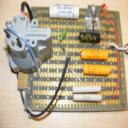Yahoo Answers is shutting down on May 4th, 2021 (Eastern Time) and the Yahoo Answers website is now in read-only mode. There will be no changes to other Yahoo properties or services, or your Yahoo account. You can find more information about the Yahoo Answers shutdown and how to download your data on this help page.
Trending News
Oscilloscope question Volts/Div on a tektronix 475A. Why can't i select over 5 volts per division?
When I attempt to turn the selector knob to anything higher it seems like it is mechanically limited from going any further. Am I missing something here?
5 Answers
- qrkLv 73 years agoFavorite Answer
When used with a x1 probe, it has a max input of 5 V/div.
When used with a x10 probe, it has a max input of 50 V/div.
The reason why you see 50 V/div is when you use a x10 probe with a "readout" pin on the probe connector, it will cause the light behind the vertical scale to change position, thus, illuminating the 50.
I would suggest downloading the manual for this scope and read it. Sounds like you are new to analog scopes. Welcome to a real scope. The 475 is a workhorse and I still use one for analog design (digital scope suck when doing analog design, especially when displaying noise).
- PhilomelLv 73 years ago
Your scope probe has a divider inside which limits the actual voltage into the probe port on the scope. If you exceed the input voltage you burn the resistors inside the scope damaging it. Don't do that !
If you are using a 1x probe the scope senses that and prevents you dialing the higher setting.
This is known as idiot proofing the scope.
- 異域秦後人Lv 73 years ago
YOUR SCOPE VOLT/DIV SELECTER CONTACTS WERE RUSTY, NEED TO REPLACE IT.
Source(s): I REPAIRED SCOPE - billrussell42Lv 73 years ago
you would usually use a 10:1 scope probe which multiplies that to 50 volts per division.
If you need even higher voltage, there are 100:1 probes that are rated for thousands of volts.
- Anonymous3 years ago
Yes. The maximum rated input voltage of the scope ;-)
Too lazy to look it up right now, but 5V/div would be something like 30..40 Volts full scale, and that scope is probably rated for something like 20..40 V maximum input voltage (check the small print on the label at the input connector). If you need to measure higher voltages, you'll need a divider probe - just make sure you don't exceed the rated voltage of that probe.





